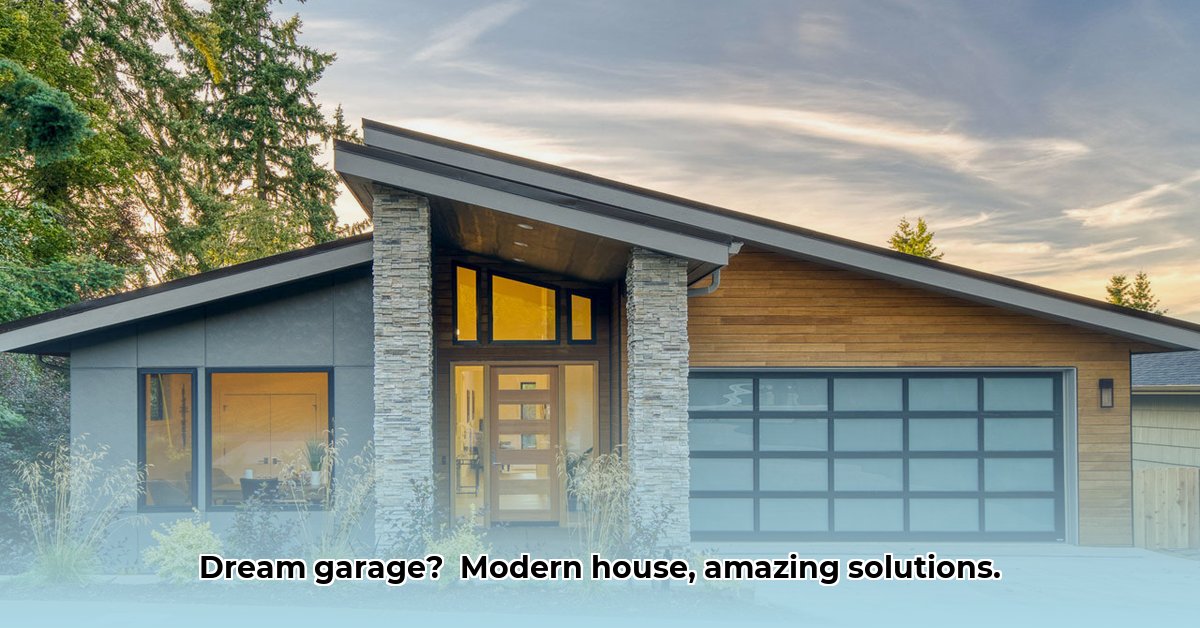Want a garage that’s way more than just a car storage space? This article will show you how to design a modern garage that’s both stylish and practical, covering everything from saving space to making it look amazing and even adding cool tech. It will explore attached, detached, and underground garages, and provide a comprehensive guide to building your dream garage, including cost considerations, maintenance tips, and future trends. For inspiration on overall home design, check out these modern house designs.
Transforming Your Garage: Modern Design for Maximum Impact
Garages are experiencing a design renaissance! They’re evolving from simple storage spaces into multifunctional extensions of our homes. This transformation enhances curb appeal and simplifies daily life. A modern garage can serve as a workshop, home office, gym, or even an entertainment area.
Optimizing Space: Smart Planning for Modern Garages
Efficient space utilization is essential. Implement clever storage solutions such as overhead racks, pull-out drawer systems, and vertical shelving. These maximize storage capacity without hindering movement. A well-organized garage eliminates clutter and optimizes space.
Modern Aesthetics: Style and Functionality Combined
Modern garage design equally prioritizes aesthetics and functionality. The garage should seamlessly blend with the home’s overall architectural style, utilizing clean lines, high-quality finishes, and a cohesive color palette. Natural light is essential for creating a welcoming space. Consider large windows, skylights, or glass-paneled doors to brighten the interior.
Integrating Smart Technology: Convenience and Security
Smart technology enhances convenience, security, and energy efficiency. Automated lighting, electric vehicle (EV) charging stations, smart garage door openers, and integrated security systems are becoming increasingly popular. Control lighting, monitor security cameras, and open/close the garage door remotely via smartphone.
Garage Types: Choosing the Right Structure
Selecting the right garage type is a crucial decision. Each type offers distinct advantages and disadvantages depending on your property, budget, and needs.
Attached Garages
Attached garages are directly connected to the house, providing convenient access and protection from the elements. They often include direct entry into the home, making grocery runs easier. Attached garages can increase property value. However, they may require modifications to existing structures and can sometimes limit natural light in adjacent rooms.
Detached Garages
Detached garages stand separately from the house, offering greater design flexibility and noise isolation. They are ideal for homeowners who want to minimize noise and fumes from entering the living space. Detached garages can also offer more privacy if used as a workshop or home office. However, they require walking outdoors to access the house and may necessitate additional utility connections.
Underground Garages
Underground garages, also known as subterranean garages, are built beneath the home or yard. They are a space-saving solution ideal for properties with limited land. Underground garages protect vehicles from the elements and can enhance security. However, they are more expensive to construct due to excavation costs and require careful planning for ventilation and drainage.
Step-by-Step Guide: Building Your Dream Garage
- Assessing Your Needs: Determine the primary use of the garage—parking, workshop, storage, or multi-purpose.
- Planning the Layout: Create a detailed floor plan that includes parking spaces, storage areas, workbenches, and access points. Consider the placement of doors, windows, and electrical outlets.
- Selecting Materials: Choose durable, low-maintenance materials that complement the home’s architectural style. Options include concrete, wood, steel, and composite materials.
- Integrating Technology: Incorporate smart home technology such as automated lighting, EV charging stations, and security systems.
- Maximizing Natural Light: Add windows, skylights, or glass-paneled doors to increase natural light and improve the ambiance.
Cost Considerations: Budgeting for Your Modern Garage
The cost of a modern garage can vary significantly depending on size, materials, features, and location. A detailed budget is essential for managing expenses.
Material Costs
Material costs typically account for a significant portion of the total expense. Prices can fluctuate based on the type of materials selected—concrete, wood, steel, or composite.
Labor Costs
Labor costs vary depending on the complexity of the project and the expertise of the contractors. Obtain multiple quotes from reputable contractors and compare their prices and services.
Permits and Fees
Building permits are required for most garage projects. Permit fees vary by location and project scope. Factor these costs into your budget.
Smart Technology Costs
Integrating smart technology can add to the overall cost. EV charging stations, smart garage door openers, and advanced security systems can range from a few hundred to several thousand dollars.
Stakeholder Goals: Perspectives on Modern Garage Design
| Stakeholder | Short-Term Goals (0-1 year) | Long-Term Goals (3-5 years) |
|---|---|---|
| Homeowners | Optimize basic storage; install smart lighting; add a workbench. | Create multifunctional spaces; upgrade to EV charging; install advanced security systems. |
| Architects/Builders | Integrate smart tech into new designs; offer energy-efficient options. | Develop prefabricated garage modules; design packages for various lifestyles and budgets. |
| Real Estate Agents | Highlight smart garage features; emphasize added value; showcase energy efficiency. | Market sustainable garage designs as key selling points; promote smart home integration. |
| Technology Providers | Improve existing automated systems; introduce user-friendly features. | Develop advanced energy storage solutions; focus on integration with home automation systems. |
Optimizing Garage Space in a Modern House Design
Key Takeaways:
- Modern garage design integrates seamlessly with the home’s aesthetic and lifestyle.
- Smart home technology and sustainable elements are essential components.
- Multifunctional spaces enhance usability and value.
Maximizing Garage Storage: Creating a Clutter-Free Zone
Smart storage solutions are essential. Utilize vertical storage, overhead racks, and wall-mounted cabinets. These maximize vertical space and keep items organized and off the floor. Use clear bins for easy identification of contents.
Integrating Smart Home Technology
Modern technology elevates garage efficiency and convenience. Plan for EV charging stations, automated lighting systems, and smart garage door openers. These technologies enhance security and improve energy efficiency.
Creating Multifunctional Spaces
Transform your garage into a versatile space that suits your lifestyle. A workshop area with built-in workbenches provides space for hobbies and DIY projects. A home gym offers fitness options without sacrificing living space.
Design Considerations
Your garage’s design should complement your home’s overall aesthetic. Choose materials and finishes that match the house’s exterior. Proper insulation, ventilation, and lighting are crucial for creating a comfortable and functional space.
Budgeting for a Modern Garage Upgrade
Budget planning is essential for optimizing garage space. Prioritize essential features based on your needs and budget. Efficient design can save money in the long run. Careful planning can help avoid unexpected expenses.
Sustainability: Eco-Friendly Choices
Incorporate sustainable features to promote environmental responsibility and cost savings. Installing solar panels on the garage roof generates renewable energy and reduces your carbon footprint. Green roofs absorb rainwater and provide insulation, enhancing energy efficiency and environmental benefits.
Eco-Friendly Modern Garage Designs with Solar Panel Integration
Key Takeaways:
- Modern garages are integrated extensions of homes.
- Eco-Friendly Modern Garage Designs with Solar Panel Integration offer environmental benefits and cost savings.
- Multi-functional designs maximize space.
Designing a Sustainable Haven
Balance green tech with style. Think beyond parking and envision a space blending sustainability, smart technology, and personal style.
Integrating Solar Power
Integrate solar panels into your garage design to reduce your carbon footprint and lower energy bills. This is a major step toward Eco-Friendly Modern Garage Designs with Solar Panel Integration.
Smart Technology Enhancements
Consider smart garage door openers, lighting, climate control, and EV charging stations to make your garage more innovative.
Maximizing Space
Use storage solutions like shelves and cabinets to maximize space. This creates an organized environment while cleverly hiding clutter.
Design Materials and Aesthetics
Choose eco-friendly materials such as recycled steel, bamboo, or reclaimed wood. Align the garage with the overall home’s design.
Practical Considerations
Develop a detailed budget and prioritize features based on your needs and financial constraints to avoid unexpected surprises.
Designing Multi-Functional Modern Garages: Home Office & Workshop Spaces
Key Takeaways:
- Modern garages are versatile spaces tailored to individual needs.
- Efficient storage solutions are crucial for maximizing space.
- Designing multi-functional modern garages: home office & workshop spaces requires careful planning and adherence to building codes.
Garage Transformation: Car Storage to Functional Living Space
Transform the garage into a productive space with designing multi-functional modern garages: home office & workshop spaces.
Implementing Smart Storage
Effective storage maximizes space and creates a harmonious environment for remote workers and home mechanics alike. Install overhead racks for seasonal items and utilize wall-mounted shelves and cabinets to keep tools and supplies organized.
Converting Garages: Expanding Living Space
Converting your garage adds square footage without the expense of an addition. Check local building codes and obtain necessary permits before starting any work. Popular options include home offices, workshops, and home gyms.
Multi-Functional Garage Design: Roadmap
Step 1: Planning and Design: Sketch your layout and note the placement of doors, windows, and electrical outlets.
Step 2: Permits and Inspections: Contact your local building department to ensure compliance with regulations.
**Step 3:
- Glass Tile Shower Ideas to Create a Stunning Bathroom Space - December 7, 2025
- Glass Wall Tile Ideas for Kitchens and Bathrooms - December 6, 2025
- Glass Tile Bathroom: Create a Beautiful, Easy-Clean Space - December 5, 2025










